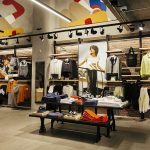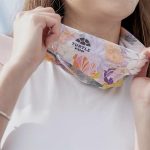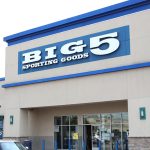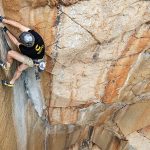With both its basketball and running segments clicking, Nike Inc. seems to have few challenges these days driving demand for its products. But even the sporting goods giant can’t do much about currency fluctuations.
The company delivered third-quarter earnings that ran past its internal expectations with both revenues and Nike Brand futures on a currency-neutral (C-N) basis climbing 14 percent. Strong demand, particularly in North America, pulled some Q4 futures orders into Q3.
But Wall Street reportedly got spooked by the continuing impact currency devaluations in developing markets are having on bottom-line results with ongoing pressure expected into Q4 and next year. On a conference call with analysts, CFO Donald Blair said the devaluations, particularly calling out the Argentine peso and Russian ruble, “will be a significant drag on next year's reported revenue, gross margin and profit growth.”
Nike gets about 30 percent of its revenue from Emerging Markets, China and Eastern and Central Europe.
Other headwinds expected to prevent its robust top-line growth from feeding directly into the bottom line are ongoing investments in product innovation and increased marketing expenses to support this year’s World Cup and retail initiatives. As a result, Nike now expects EPS in the fiscal year beginning in June to be “somewhat” below the company's mid-teens-percentage target.
With the strong future rates, C-N revenue growth for FY15 is still projected to be at or slightly above its high single-digit target range.
Shares of Nike slid xx to xx Friday after the report. Nike had reached a 52-week high of $80.26 on Mar. 18 and remains well above its 52-week low of $53.53.
“For a company that does business in more than 190 countries, volatility is a fact of life,” said Mark Parker, president and CEO, on the call. At the same time, he noted that Nike’s diverse set of categories, geographies, products, brands and distribution channels makes Nike “best-positioned to manage through an ever-changing macro environment.”
In the third quarter ended Feb. 28, earnings rose 3.5 percent in the third quarter, to $685 million, or 76 cents a share. Revenues advanced 12.7 percent to $6.97 billion, growing 14 percent on a C-N basis for the Nike Brand and 16 percent for Converse.
Results handily topped Wall Street’s consensus estimates that called for EPS of 72 cents a share on nearly $6.7 billion in revenue.
Beyond top-line growth, the EPS gain was driven by gross margin expansion, a lower tax rate and slightly lower average share count, partially offset by the impact of higher SG&A investments in both Nike Brand and Converse as well as in business capabilities.
On a global basis, total Nike Brand revenues were up 12.4 percent in the quarter to $6.55 billion and grew 14 percent on a C-N basis. Growth was seen across all geographies and key categories, including double-digit growth in its largest categories of sportswear, running and basketball. Nike Brand DTC grew 23 percent, driven by 10 percent comp store growth and 57 percent growth online. Total Nike Brand EBIT advanced 9.7 percent to $1.03 billion.
The 14 percent hike in Nike Brand futures orders on a C-N basis was driven by a 9 percent increase in units and a 5 percent gain in average selling price. The increase was led by “extraordinary growth” in the Emerging Markets and Western Europe, as well as double-digit growth in the global football, basketball, and women's training categories. On a reported basis, futures grew 12 percent, reflecting weaker developing market currencies.
By category for the Nike Brand globally, footwear was up 14.5 percent to $4.22 billion, Apparel gained 9.7 percent to $1.89 billion, and Equipment rose 6.6 percent to $419 million. On a C-N basis, sales increased 15 percent in Footwear, 10 percent in Apparel and 7 percent in Equipment.
Highlighting a few star categories globally, Trevor Edwards, president, Nike Brands, on the call noted that running grew at a double-digit rate in Q3, boosted by a good response to Flyknit Air Max and Flyknit Lunar2. Running apparel continues to gain share on strong demand for its new Dri-FIT Knit products.
Women’s’ in run grew faster than its men's business again in quarter, and is particularly benefiting from Nike Training Club, a concept within Nike stores offering cross-merchandise collections from women's running, training, and sportswear as well as trained associates. It expects to have nearly 50 Nike Training Club locations globally by the end of fiscal year 2014.
Jordan saw the largest one-day product launch in the brand's history with the release of the latest Air Jordan 11. The quarter also marked the debut of the first Jordan stand-alone retail concept in New York City in partnership with Footaction, called Flight 23.
Sportswear has also regained momentum for Nike Brand with the aid of new silhouettes, fabrics and styling, delivering double-digit growth globally in Q3.
In the North America region, revenues for Nike Brand in the quarter grew 12.1 percent to $3.07 billion and grew 12 percent on C-N basis. Footwear revenues grew 12.9 percent to $1.93 billion, Apparel gained 11.4 percent to $925 million, and Equipment moved up 8.5 percent to $216 million. On a C-N basis, sales increased 13 percent in Footwear, 12 percent in Apparel, and 9 percent in Equipment.
The NA gains were driven by double-digit growth across nearly all key categories, led by basketball, sportswear, men's and women's training, and global football. DTC revenue grew 19 percent in the quarter, driven by 8 percent comp sales growth in stores, and significantly higher sales for nike.com.
EBITDA in the NA region grew 11.2 percent to $726 million, due to strong revenue growth and gross margin expansion, partially offset by higher marketing spending to support new product launches. Futures were ahead 9 percent in both dollars and on a C-N basis.
“We drove excitement in the marketplace with innovative products and elevated retail experiences, which included both DTC locations and our wholesale partners, such as Fieldhouse at Dick's Sporting Goods and also the Yardline at Champs,” said Edwards. Exposure around the Super Bowl also supported momentum in the region.
“As I have said before, Nike is in the business of making big moments bigger, which is exactly what we did, and we couldn't be happier with the results,” said Edwards.
In Western Europe, sales on a C-N basis gained 19 percent, led by a 24 percent gain in Footwear with Apparel ahead 8 percent and Equipment up 7 percent. Revenues in the UK and AGS, comprised of Austria, Germany and Switzerland, were up double-digits for the second quarter in a row. The only territory decline came in Italy. Revenue grew double-digits for every key category except action sports. DTC revenues were up 29 percent, driven by 14 percent comp store growth and strong growth online.
On a reported basis, revenues in Western Europe grew 22.2 percent to $1.29 billion. Footwear increased 28.2 percent to $891 million, Apparel gained 10.8 percent to $338 million, and Equipment advanced 10.5 percent to $63 million.
EBITDA jumped 53.6 percent to $275 million, driven by revenue growth, significant gross margin expansion, and SG&A leverage. Futures were ahead 33 percent in dollars and 30 percent on a C-N basis.
Edwards said Western Europe is benefiting from efforts taken two years ago to restructure the region to work closer with its wholesale partners is segmenting and differentiating the market.
“Our work to transform the marketplace with our own DTC locations and key retail partners, such as JD Sports and Foot Locker has improved the experience for our consumers. All told, we have strengthened our brand and expanded the potential of our business, and we are just getting started,” said Edwards.
In Greater China, overall sales on a C-N basis advanced 7 percent, led by expansion in sportswear, basketball, and running. A 12 percent gain in Footwear offset declines of 2 percent in Apparel and 7 percent in Equipment.
On a reported basis, sales grew 8.7 percent to $697 million. Footwear increased 13.9 percent to $467 million but Apparel was flat at $199 million; and Equipment declined 3.1 percent to $31 million. EBIT moved up 7.3 percent to $234 million as revenue growth and gross margin expansion were partially offset by higher SG&A spending, reflecting investments in its new China headquarters facility and DTC operations.
Edwards said the results in Greater China “reflect progress” against its ongoing reset of the region.
“We worked with our wholesale partners to better balance supply and demand, and we have made changes to the supply chain that are improving inventory levels in the marketplace,” said Edwards. A particular success has been DTC, with new merchandising concepts helping drive revenue up 27 percent with comp growth of 11 percent and expanding margins. Wholesale partners are also seeing positive results in reset doors, which continue to outpace the rest of the fleet.
Due to planned changes in its seasonal product flow, however, futures are down 3 percent on a C-N basis, and Q4 revenues are expected to be slightly down. On a reported basis, futures are down 1 percent
“We still have work to do in China in our China reset, but we feel great about our progress,” said Edwards.
In Central & Eastern Europe, sales on a C-N basis were up 22 percent with increases of 27 percent in Footwear, 17 percent in Apparel and 9 percent in Equipment. Every territory except Israel reported higher revenues. Russia, Turkey, Poland and Greece grew at a double-digit pace.
On a reported basis, Central & Eastern Europe sales grew 17.5 percent to $356 million. Footwear added 23.2 percent to $207 million, Apparel increased 12.2 percent $129 million, and Equipment was flat at $20 million. EBITDA advanced 23.4 percent to $79 million as revenue growth and gross margin expansion more than offset higher marketing spend related to the Winter Olympics. Futures were ahead 7 percent in dollars and 13 percent C-N.
In Japan, revenues on a C-N basis were up 10 percent overall with gains of 14 percent in Footwear, 4 percent in Apparel, and 11 percent in Equipment. The gains were driven by higher revenues in nearly every key category. On a reported basis, revenues slumped 9.2 percent to $177 million. Footwear gave back 6.1 percent to $92 million, Apparel was down 15.7 percent to $59 million, and Equipment was off 3.7 percent to $26 million.
Japan’s EBIT was down 12.5 percent to $21 million, reflecting the impact of the weaker yen, as well as increased SG&A spending behind the launch of nike.com in Japan. Futures were down 6 percent in dollars and 1 percent C-N.
In its Emerging Markets region, sales on a C-N basis grew 19 percent in total. Apparel led the way with a 31 percent gain, followed by Equipment, up 19 percent, and Footwear, 15 percent. Revenues for nearly every category increased double-digits, led by running, football, and sportswear. Seven of the nine territories there reported double-digit revenue growth, led by Brazil, Mexico, and SOCO (Argentina, Uruguay and Chile).
Edwards noted that Nike continues to work with a third-party logistic provider to resolve distribution challenges in Mexico and was able to ship to demand in the period. Said Edwards, “Demand for our product in Mexico remains strong, and we are working closely with our wholesale partners to properly manage the flow of product into the marketplace.”
Edwards noted that the region will be a key focus in 2014 with campaigns and launches tied to the World Cup.
On a reported basis, Emerging Markets sales were up 8.1 percent to $937 million. Sales increased 4.6 percent to $631 million in Footwear, 18.0 percent to $243 million in Apparel, and 8.6 percent to $63 million in Equipment. EBIT rose 6.0 percent to $229 million, reflecting the significant adverse impact of currency devaluations, as well as higher SG&A spending on infrastructure and DTC. Futures were ahead 12 percent in dollars and 24 percent C-N.
Converse revenues jumped 16.3 percent in the quarter to $420 million in dollars and also increased 16 percent C-N. The gains were driven by continued strength in direct distribution markets, particularly the US, China, and the UK. Blair said on the call, “The Chuck Taylor franchise continues to deliver sustained, profitable growth, and we are making progress extending the Converse brand in footwear and apparel.”
Blair also said Converse is “developing the marketplace for the Converse brand,” by enhancing presentation in wholesale accounts, expanding DTC, and transitioning new countries to direct distribution. So far this year, Converse has converted Scandinavia and Taiwan to direct distribution with more planned for FY15.
Converse EBIT gained 9.9 percent to $133 million as higher revenue and gross margins were partially offset by increased SG&A investments in demand creation, infrastructure and DTC.
Companywide gross margin expanded 30 basis points to 44.5 percent. Higher average prices and continued growth in the higher margin DTC business offset higher product input costs, unfavorable foreign exchange rates, and higher discounts, reflecting actions to clear excess inventory in select markets.
SG&A expenses increased 16 percent, driven by an increase in marketing spend of 18 percent to support the World Cup and cover investments in retail product presentation for wholesale accounts. As a percent of sales, SG&A increased to 31.1 percent of revenues versus 30.1 percent a year ago.
Looking ahead, Q4 revenue are expected to grow at a high single-digit rate, below its rate of futures growth, largely due to the timing of shipments at the beginning and end of Q4, as well as lower levels of at-once and closeout sales. For the full year, Nike now expects revenue growth at the top end of its high single-digit target range.
Gross margin is expected to expand by 50 to 75 basis points, somewhat better than expected, due to a shift in mix to higher margin products and geographies, as well as the ongoing strength in its DTC business. For the full year, gross margins are expected to expand about 90 basis points.
SG&A is expected to grow at a high teens rate in the fourth quarter, with World Cup initiatives expected to hike marketing spend by over 30 percent in the fourth quarter.













